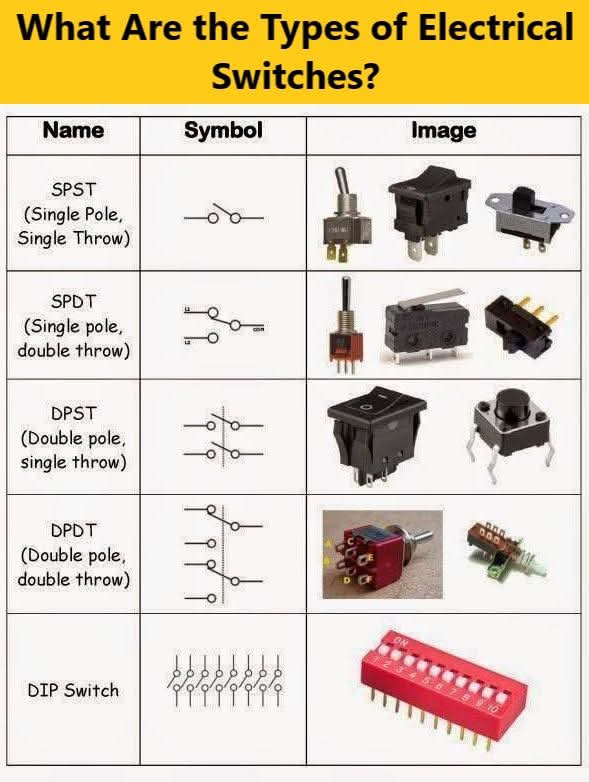Types of electrical switches:
SPST (Single Pole, Single Throw):
• Symbol: A simple switch with one input and one output.
• Function: This switch connects or disconnects a single circuit. It's like a basic on/off switch.
• Image: Shows various forms of SPST switches, including toggle, rocker, and slide switches.
SPDT (Single Pole, Double Throw):
• Symbol: A switch with one input and two outputs.
• Function: This switch can connect the input to one of two different outputs, allowing for switching between two different circuits or states. It's commonly used for switching between two different power sources or for changeover functions.
• Image: Depicts toggle, slide, and push-button SPDT switches.
DPST (Double Pole, Single Throw):
• Symbol: Two SPST switches in parallel, each controlling a separate circuit.
• Function: This switch controls two separate circuits simultaneously, essentially like having two SPST switches operated by a single mechanism.
• Image: Shows examples like a rocker switch and a push-button switch.
DPDT (Double Pole, Double Throw):
• Symbol: Two SPDT switches in parallel.
• Function: This switch can control two circuits and switch each between two different states. It's often used in applications where you need to control the direction of current flow in two circuits, like in reversible motors or complex switching systems.
• Image: Features rotary switches and toggle switches.
DIP Switch (Dual In-line Package Switch):
• Symbol: A series of small switches arranged in a row.
• Function: DIP switches are used for customizing the behavior of an electronic device. Each switch in the package can be set to on or off, typically used in settings or configuration of electronic circuits.
• Image: Shows a DIP switch with multiple toggle switches.
Push-Button Switch:
• Symbol: Typically shown as a circle or rectangle with a line through it indicating the button.
• Function: This switch is activated by pressing a button. It can be momentary (returns to its original state when released) or maintained (stays in the new state until pressed again). They are commonly used in applications like doorbells, start/stop buttons, or reset buttons.
• Image: Typically looks like a button you press.






No comments:
Post a Comment